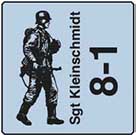Yamato hugger
Posts: 5475
Joined: 10/5/2004
Status: offline

|
Actually the tactic works just fine as well in WitP. Always has. But people seem to forget the minor detail that a unit cant move and attack at the same time, so those people I think erroneously think that not only are units attacking, but moving at the same time and this is where they have a problem with it, as would I if that were the case. But it isnt. You either attack OR move, not both.
In WitP you cant move from an enemy occupied hex to an enemy occupied or contested hex, but as long as the hex you are moving to is friendly controlled or not controlled by either player (in other words, when you hit "W" there is no "J" in the hex if you are allied or "A" in the hex if you are Jap) then the move is allowed.
AE is different in that regard that enemy control of a hex is meaningless, or almost so. Its the HEXSIDES that count. You CAN move from an enemy occupied hex to another enemy occupied hex (even an enemy controlled base to an enemy controlled base as I will show) as long as you control the hexsides between them. I will give you several examples (that may make your head hurt  ) In the first 3 following examples, let us assume that both Clark and Manila are allied controlled and both are Japanese occupied (meaning both allied and Jap units in the hexes). Note, Im not saying either situation 2 or 3 could ever occur but showing how movement works. (picture below for 1, 2, and 3 - Termmy taught me how to draw, so dont blame me. C is Clark, M is Manila, and the lines are who controls the hexsides between them). ) In the first 3 following examples, let us assume that both Clark and Manila are allied controlled and both are Japanese occupied (meaning both allied and Jap units in the hexes). Note, Im not saying either situation 2 or 3 could ever occur but showing how movement works. (picture below for 1, 2, and 3 - Termmy taught me how to draw, so dont blame me. C is Clark, M is Manila, and the lines are who controls the hexsides between them).
Example 1) The hexsides between them are allied controlled (in other words, no Jap units moved between the 2 in either direction). Allied units can move freely between the 2 hexes in either direction, the Japs can not move direct between them in either direction. This would be the normal situation as long as neither of them fell to the Jap.
Example 2) The Japs had taken Manila and moved into Clark from there. The allies re-take Manila and the Japs move back into Manila from another hex (but not from Clark). So both bases are allied controlled, and both are Japanese occupied but the hexside in Clark that borders Manila (the SE one) is Jap controlled (because Jap units moved in from that hex and thus were the last to pass through this hexside) but the NW hexside in Manila (the one bordering Clark) is allied controlled (because when you take a hex and force all the defenders out you get control of all the hexsides in that hex). So now what can happen is Jap units can move FROM Clark TO Manila, but the Jap units in Manila can NOT move to Clark. The reverse is true of the allies. The allied units in Manila could move to Clark (because they control that hexside in the Manila hex) but could NOT move from Clark to Manila (because that hexside in the Clark hex is Jap controlled). Head hurt yet? Theres more 
Example 3) Same situation as above. But now IF the Japs move from Clark to Manila they would then control the Manila NW hexside because they were the last to move through this hexside. So in this situation you have both Manila AND Clark allied controlled and occupied, but only Jap units could move between the 2. Your head hurt yet? More coming 
Edit: Each hex has its own hexsides for control purposes. So in reality each hexside between 2 hexes has 2 hexsides: hex A || hex B so here 1 player can control the east hexside of hex A while the other controls the west hexside of hex B.
Example 4) A Jap unit and an allied unit both enter a non-base hex that was vacant last turn (so neither side controlled any hexsides in it last turn). Since both sides moved in on the same turn, the Jap controls the hexside they moved in from, the allies control the hexside they came in from, and neither player controls the rest. So in this situation, either side could move to any adjacent hex EXCEPT the one the enemy moved in from.
Example 5) As in 4, only now both are moving to the same hex. Let us say the allied entered from the west, and the Japs from the east, and both move NW from there (neither stops to fight). I have never tested this (maybe I should) but what I THINK would happen is they would both move into the next hex and after doing so all hexsides would be uncontrolled except the one they both came from which would be Jap controlled (because the allies move first). Now its possible that since the allies would be leaving hex A first, they would get control of the NW hexside before the Jap movement which would block the Japs move, but like I said, I should test that.
Now supply is another matter, and frankly, it drives me crazy. Since you only "control" the hex you are physically in at the moment and no one controls any hexsides of unoccupied hexes, its actually possible for both sides to use the same rail line supplying their forces (or road, or whatever supply path).
In the attached pic, if you imagine that hexes 1 and 2 are unoccupied then the Chinese and Japs can both trace supply along this same rail line in the same turn because neither side controls any of the hexsides along it (shown by colored arrows).
In the base hex on the north, if the Chinese controlled the SW hexside, their supply could move through that hexside, but their control of that hexside doesnt stop the supply from coming INTO that hex.
So the general rule of thumb is this: hexside control only stops movement FROM that hex through that hexside. It does NOT stop movement from another hex INTO that one. It takes a while to adjust your mind to this, but its actually a nice concept for unit movement but I personally have reservations on the supply movement (my own opinion).

 Attachment (1) Attachment (1)
< Message edited by Yamato hugger -- 6/7/2009 11:01:00 AM >
_____________________________
|
 Printable Version
Printable Version













 And if you say it wonīt make it for the first patch it nearly does sound as if someone would consider it a strange "feature" and while itīs no game breaker it may be fixed in patch number 117.
And if you say it wonīt make it for the first patch it nearly does sound as if someone would consider it a strange "feature" and while itīs no game breaker it may be fixed in patch number 117. 
 ) feature that your troops are actually marching THROUGH the enemy. This is ridicoulos and actually no matter if you care or not, if you generally think about game exploits or broken features like this then say good night as AE will be in the same state as WITP was when it came out.
) feature that your troops are actually marching THROUGH the enemy. This is ridicoulos and actually no matter if you care or not, if you generally think about game exploits or broken features like this then say good night as AE will be in the same state as WITP was when it came out.  How can we increase their quality? Are we able to withdraw some crack combat pilots to act as instructors and help in training pilots in flight schools? Something like that was mentioned a year ago, but I don't understand what is it working like. Or if it has been implemented at all...
How can we increase their quality? Are we able to withdraw some crack combat pilots to act as instructors and help in training pilots in flight schools? Something like that was mentioned a year ago, but I don't understand what is it working like. Or if it has been implemented at all...
















 New Messages
New Messages No New Messages
No New Messages Hot Topic w/ New Messages
Hot Topic w/ New Messages Hot Topic w/o New Messages
Hot Topic w/o New Messages Locked w/ New Messages
Locked w/ New Messages Locked w/o New Messages
Locked w/o New Messages Post New Thread
Post New Thread